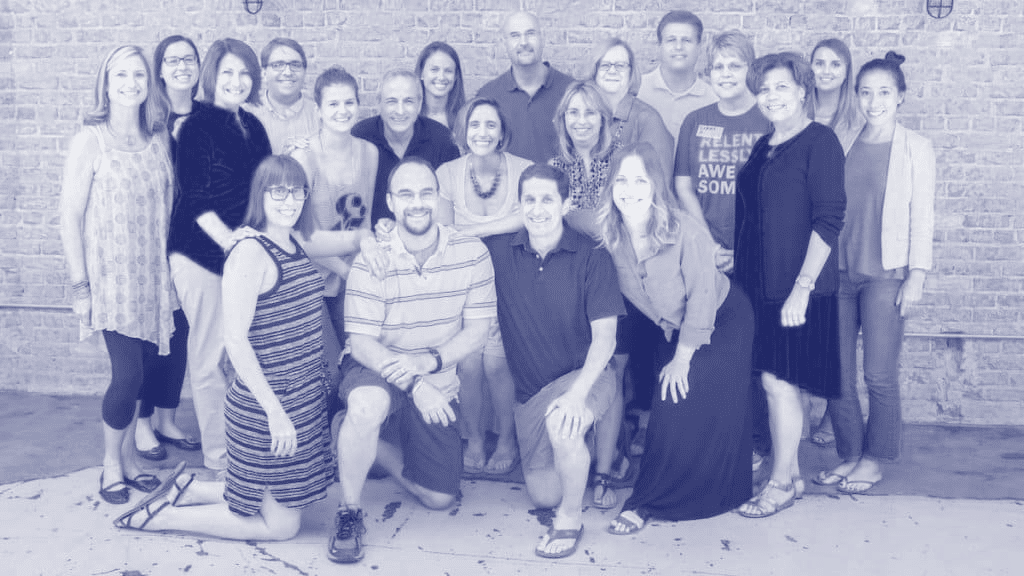I vowed to avoid “heroic efforts” as I became President of a high-performing marketing association in early 2016.
How high-performing? The prior years, we’d ranked #3, #2, #1, and #1 internationally… but the wins had come at a high cost.
After years of continuous “bigger is better” pressure, volunteers were getting burned-out. Serving as President (and President-Elect) meant committing to two years in a stressful, unpaid 20 hour/week job. And every month (or week!), there was a new crisis to manage.
I’m not opposed to heroic measures altogether—sometimes they’re what you need, especially in truly dire situations—but I’m concerned when heroic measures become the norm rather than the exception.
To me, our organization’s strategic and operational approaches were unsustainable—we’d achieved great results, but at too great a cost. Historically, it appears we opted to “maximize” rather than “optimize.” That is, we pursued raw continuous growth rather than a more intentional return on investment (ROI).
And now, I was in a position to do something about it.
Commitment: Avoid our past focus on heroic efforts
As I stepped into the top role, I concluded we needed to do things differently. My goal was to apply my executive coaching expertise to help my entire team—the 15 executive board members and (indirectly) all 100 volunteers—as we served our 700+ members.
In short, we’d seek to avoid heroic efforts. We’d do our best, but wouldn’t push the all-volunteer team beyond what was reasonable. We’d commit to “optimize” over “maximize,” even if our membership shrank in size, or we didn’t win the annual chapter-ranking awards. (Although I hoped we’d earn a smaller award for Leadership.)
I knew this would require a shift in leadership culture… and I found a book to help me “enlist” my team in making the changes happen across the organization.
How we’d get there: “Turn the Ship Around!” and “Leader-Leader”
As with many agencies, the leadership team was a bottleneck—because subordinates were often asking what to do. I knew this was traditionally part of the association chapter’s history, and I knew that reducing those questions would be vital in shifting the culture. As they say, “If your team keeps asking you what time it is… build them a clock.”
As we started the year, I assigned my executive team to read the book Turn the Ship Around!: A True Story of Turning Followers into Leaders, by former Navy submarine captain L. David Marquet.
- Marquet describes how he took his sub from “worst to first,” based on a leadership technique that flipped the decisionmaking process. He called it “Leader-Leader” (versus the traditional “Leader-Follower”).
- Instead of subordinates asking their boss what to do, they’d tell the boss, “I intend to…” The boss could review the plan, ask clarifying questions about assumptions, and typically say “Proceed.”
- To save people time—if they didn’t have bandwidth to read the entire book—I shared this 10-minute whiteboard video based on the key points in Turn the Ship Around! (Go watch it, then read the book.)
From doing the Grinnell Leadership boot camp, and from The Human Brand‘s “Warmth & Competence” model, I knew my natural tendency was to prioritize Competence (at the expense of Warmth). As a result, I built Warmth-creation into my leadership process. This proved to be especially important when I faced unexpected challenges—because heroic efforts tempt us to prioritize Competence (results) over Warmth (your team’s morale).
To stay on track, I did weekly calls with my predecessor, the Immediate Past President. We used the time to troubleshoot problems and discuss my own “I intend to…” plans. This weekly cadence helped me stay weeks and even months ahead, while handling daily challenges. I also did ongoing calls with my successor, the President-Elect, to get her feedback and to share my decision process, to help her succeed when she stepped into the top role.
I also discussed my volunteer leadership with my own coach. As President-Elect and as President, this topic consumed 50-90% of my weekly coaching calls… for two years. It helped to have an objective sounding board, for a mix of unbiased advice and someone equally committed to my improving as a leader.
Results: Good for my team… but mixed for me
How did it go? During the 2016-2017 chapter year, I managed to create a largely “no heroic efforts” experience for my executive team… but not so much for myself as the president.
There were several points that I found myself inexorably drawn into heroic efforts—in retrospect, breaking the commitment I intended to model for my team. Here’s where I failed on my initial “no heroic efforts” commitment:
- Year-End Member Recruiting: When it appeared our membership would drop 20% year-over-year, I organized a push in the last two months to keep membership from shrinking. I split the process into individual initiatives across my 15-person leadership team. Those weren’t quite heroic efforts from each person, but certainly heroic across the entire chapter. In retrospect, I should have left membership drop. (In the end, it did drop… albeit by 5% rather than 20%.) [Alternative: Set reasonable targets that don’t require last-minute “emergency” efforts.]
- Events: We’d grown our signature monthly luncheons from less than 100 to an average of 140 attendees per event (and some with 200+ people). We used this to increase event production values… but the increase in fixed costs created higher pressure to sell-out every time. In the weeks before each event, we were pushing everyone to promote the event, to sell tickets. And it happened nearly every month; in retrospect, this suggested the sales growth was unsustainable. [Alternative: Don’t raise your fixed costs beyond what you can reasonably handle.]
- Team Oversight: Historically, I knew at least one of my VPs would struggle—but in my year, I had challenges with four. Three of those situations turned out OK. But my biggest mistake was failing to notice a fourth VP was flailing, until halfway through the year. By then, it was too late to replace them, and I stepped in to fill the gaps they’d created—requiring heroic efforts to fix things. [Alternative: Pay attention to your team’s performance, to fix small problems before they become big problems.]
- Time Commitment: I worked hard to reduce my team’s time commitment… but didn’t manage to reduce my own time commitment. My year as President was 20 hours a week, as an unpaid part-time job. I realized that when you’re reducing a role’s time commitment while also performing in the role… the time commitment doesn’t go down. [Alternative: Accept that “rebuilding the plane while flying the plane” is inherently time-consuming, and pace yourself accordingly.]
Yet on the whole, I feel like I achieved a major shift in culture—for the President role and for those on my team.
Heroic efforts are seductive… and it’s hard to prove the ROI
Heroic efforts are inherently seductive—”if we push hard to do X, Y, and Z, we’ll succeed”—and hard to measure.
- When you’re in panic mode, it’s easy to want to throw lots of time (and money) at a problem. Yet you don’t know if that’ll work, or if the result will merit the effort required.
- Hindsight is 20/20—yet we have no hindsight in the heat of our heroic efforts. This leaves you guessing about how hard to push yourself and others, relative to the goals you want to achieve.
This means ROI calculations—on the “investment” via heroic efforts—are difficult to calculate accurately. Perhaps you could have worked less hard and still met your goal. Or perhaps your efforts would never have succeeded, no matter how hard to you push—in which case it’s smarter to choose a Plan B instead. You don’t know for sure until after you’ve expended the effort.
Annual awards: A surprise phone call
What about the annual awards, and how we ranked among 75 chapters across North America? A few months after I finished my goal, I was at the gym when our chapter advisor called. She shared the news: We were the #2 chapter in the world!
It was a drop from #1 the two years before, but I felt like it was a great ROI: we’d become #2 with fewer heroic efforts than it had taken to become #1. Yet I wondered how we’d have performed if I’d achieved my original goal of zero heroic efforts.
Since my tenure: A culture shift away from heroic efforts
In Turn the Ship Around!, L. David Marquet argues that the best leaders create a legacy that continues beyond your tenure in office. That is, when the best leaders leave, their impact continues.
In my chapter strategic plan, I covered this topic as we started the fiscal year. Looking ahead, I wrote:
“Given our long-term view, we can’t fully judge the success of our 2016-2017 focus on sustainable quality until we see the chapter doing great in 2017-2018… and 2021-2022… and 2051-2052.”
So, how did it go? Years after I chose “avoid heroic efforts” as a key leadership value, I’ve seen shifts in the chapter’s leadership culture. Removing the pressure to be #1 means the chapter has more flexibility to try new things.
- My effort to shift our leadership pipeline in 2016 has produced long-term results—leadership diversity grew over six years to be higher than ever before, to more closely match the chapter as a whole.
- Since we ranked #2 under my presidency (and #1 twice before that), the chapter has not ranked in the top 3—but the organization continued to receive other awards annually, for excellence in specific topic areas.
- Event timing expanded beyond “luncheons only”—which attracted more of the membership base, while simultaneously reducing fixed costs and allowing more-sustainable sales targets.
- To formalize the future leadership pipeline, the chapter identified “assistant VPs” for each VP role.
- The chapter paused its annual multi-day conference. As conference director before becoming President, I saw how the event created a marquee experience—but delivering that experience required an enormous drain on resources.
As is true for any organization, there are still some challenges. But the pace of leadership culture is certainly more sustainable than what I inherited—that is, heroic efforts are now the exception rather than the norm.
Your agency: Deciding how to approach heroic efforts
What are your takeaways from my allegory around heroic efforts as leaders? Especially today, during tough times, consider:
- Decide whether “heroic efforts” are part of your leadership toolkit—or if they’re explicitly excluded.
- Pre-define levels of heroic efforts (e.g., low, medium, and high), including what would trigger each level.
- Choose when you’ll stop any heroic efforts—regarding clients, employees, initiatives, or your agency as a whole.
- Accept that sometimes you’ll panic, and you’ll exert more heroic efforts than you originally planned.
- Share your commitments (about heroic efforts) with those around you, so they can support your choices.
- Accept that whatever actions you chose to take, they were likely what made sense at the time.
During stressful times, it’s harder than ever to resist “heroic efforts.” To be clear, you don’t need to avoid heroic efforts completely—they might be just what you need right now, as uncertainty and recession loom.
But as the entire world struggles, I encourage you to be intentional about how you approach heroic efforts, including the ROI on your commitments and how they fit your agency’s Values, Goals, and Resources (VGR). Good luck!
Questions: How do you approach Heroic Efforts at your agency?


